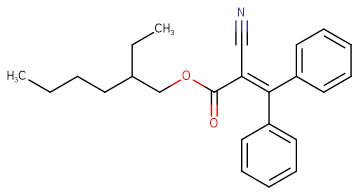
Octocrilene
CAS No. 6197-30-4
Octocrilene( —— )
Catalog No. M15345 CAS No. 6197-30-4
Octocrylene is an organic compound used as an ingredient in sunscreens and cosmetics.
Purity : >98% (HPLC)
 COA
COA
 Datasheet
Datasheet
 HNMR
HNMR
 HPLC
HPLC
 MSDS
MSDS
 Handing Instructions
Handing Instructions
| Size | Price / USD | Stock | Quantity |
| 500MG | 37 | In Stock |


|
| 1G | Get Quote | In Stock |


|
Biological Information
-
Product NameOctocrilene
-
NoteResearch use only, not for human use.
-
Brief DescriptionOctocrylene is an organic compound used as an ingredient in sunscreens and cosmetics.
-
DescriptionOctocrylene is an organic compound used as an ingredient in sunscreens and cosmetics. It is an ester formed by the condensation of a diphenylcyanoacrylate with 2-ethylhexanol. It is a viscous, oily liquid that is clear and colorless. This organic compound can penetrate into the skin where it acts as a photosensitizer. This results in an increased production of free radicals under illumination.
-
In Vitro——
-
In Vivo——
-
Synonyms——
-
PathwayOthers
-
TargetOther Targets
-
RecptorOthers
-
Research AreaOther Indications
-
Indication——
Chemical Information
-
CAS Number6197-30-4
-
Formula Weight361.48
-
Molecular FormulaC24H27NO2
-
Purity>98% (HPLC)
-
SolubilityDMSO: 10 mM
-
SMILESCCCCC(CC)COC(=O)C(C#N)=C(C1=CC=CC=C1)C1=CC=CC=C1
-
Chemical Name——
Shipping & Storage Information
-
Storage(-20℃)
-
ShippingWith Ice Pack
-
Stability≥ 2 years
Reference
1.Hanson KM. Free Radic Biol Med. 2006 Oct 15;41(8):1205-12.
molnova catalog



related products
-
2-Naphthol
2-Naphthol, or β-naphthol, is a fluorescent colorless crystalline solid with the formula C10H7OH.
-
Co 102862
Co 102862 is a voltage-gated sodium channel blocker. Co 102862 can be used for anticonvulsant studies.
-
Sodium benzoate
Sodium benzoate is a D-Amino Acid Oxidase Inhibitor.Sodium Benzoate is a Food Preservative.



 Cart
Cart
 sales@molnova.com
sales@molnova.com


